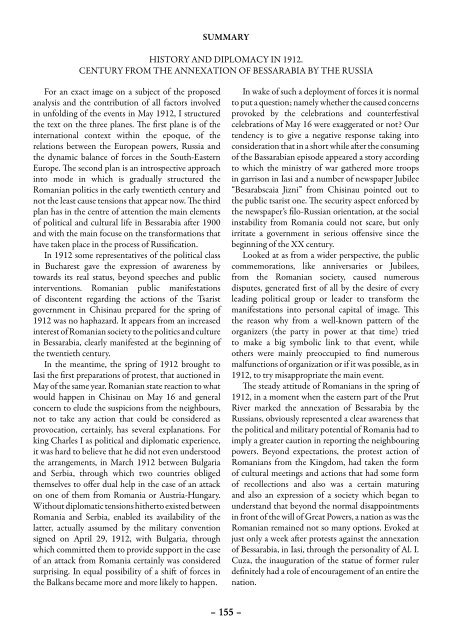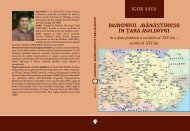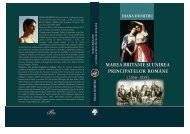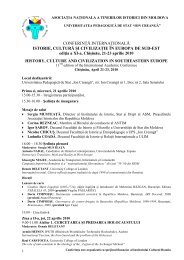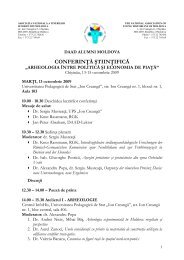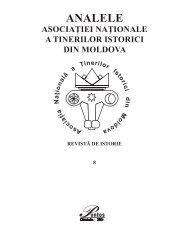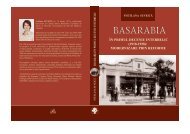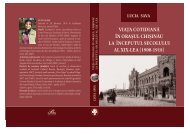aici - Asociatia Tinerilor Istorici din Moldova
aici - Asociatia Tinerilor Istorici din Moldova
aici - Asociatia Tinerilor Istorici din Moldova
You also want an ePaper? Increase the reach of your titles
YUMPU automatically turns print PDFs into web optimized ePapers that Google loves.
SUMMARY<br />
HISTORY AND DIPLOMACY IN 1912.<br />
CENTURY FROM THE ANNEXATION OF BESSARABIA BY THE RUSSIA<br />
For an exact image on a subject of the proposed<br />
analysis and the contribution of all factors involved<br />
in unfol<strong>din</strong>g of the events in May 1912, I structured<br />
the text on the three planes. The first plane is of the<br />
international context within the epoque, of the<br />
relations between the European powers, Russia and<br />
the dynamic balance of forces in the South-Eastern<br />
Europe. The second plan is an introspective approach<br />
into mode in which is gradually structured the<br />
Romanian politics in the early twentieth century and<br />
not the least cause tensions that appear now. The third<br />
plan has in the centre of attention the main elements<br />
of political and cultural life in Bessarabia after 1900<br />
and with the main focuse on the transformations that<br />
have taken place in the process of Russification.<br />
In 1912 some representatives of the political class<br />
in Bucharest gave the expression of awareness by<br />
towards its real status, beyond speeches and public<br />
interventions. Romanian public manifestations<br />
of discontent regar<strong>din</strong>g the actions of the Tsarist<br />
government in Chisinau prepared for the spring of<br />
1912 was no haphazard. It appears from an increased<br />
interest of Romanian society to the politics and culture<br />
in Bessarabia, clearly manifested at the beginning of<br />
the twentieth century.<br />
In the meantime, the spring of 1912 brought to<br />
Iasi the first preparations of protest, that auctioned in<br />
May of the same year. Romanian state reaction to what<br />
would happen in Chisinau on May 16 and general<br />
concern to elude the suspicions from the neighbours,<br />
not to take any action that could be considered as<br />
provocation, certainly, has several explanations. For<br />
king Charles I as political and diplomatic experience,<br />
it was hard to believe that he did not even understood<br />
the arrangements, in March 1912 between Bulgaria<br />
and Serbia, through which two countries obliged<br />
themselves to offer dual help in the case of an attack<br />
on one of them from Romania or Austria-Hungary.<br />
Without diplomatic tensions hitherto existed between<br />
Romania and Serbia, enabled its availability of the<br />
latter, actually assumed by the military convention<br />
signed on April 29, 1912, with Bulgaria, through<br />
which committed them to provide support in the case<br />
of an attack from Romania certainly was considered<br />
surprising. In equal possibility of a shift of forces in<br />
the Balkans became more and more likely to happen.<br />
In wake of such a deployment of forces it is normal<br />
to put a question; namely whether the caused concerns<br />
provoked by the celebrations and counterfestival<br />
celebrations of May 16 were exaggerated or not Our<br />
tendency is to give a negative response taking into<br />
consideration that in a short while after the consuming<br />
of the Bassarabian episode appeared a story accor<strong>din</strong>g<br />
to which the ministry of war gathered more troops<br />
in garrison in Iasi and a number of newspaper Jubilee<br />
“Besarabscaia Jizni” from Chisinau pointed out to<br />
the public tsarist one. The security aspect enforced by<br />
the newspaper’s filo-Russian orientation, at the social<br />
instability from Romania could not scare, but only<br />
irritate a government in serious offensive since the<br />
beginning of the XX century.<br />
Looked at as from a wider perspective, the public<br />
commemorations, like anniversaries or Jubilees,<br />
from the Romanian society, caused numerous<br />
disputes, generated first of all by the desire of every<br />
lea<strong>din</strong>g political group or leader to transform the<br />
manifestations into personal capital of image. This<br />
the reason why from a well-known pattern of the<br />
organizers (the party in power at that time) tried<br />
to make a big symbolic link to that event, while<br />
others were mainly preoccupied to find numerous<br />
malfunctions of organization or if it was possible, as in<br />
1912, to try misappropriate the main event.<br />
The steady attitude of Romanians in the spring of<br />
1912, in a moment when the eastern part of the Prut<br />
River marked the annexation of Bessarabia by the<br />
Russians, obviously represented a clear awareness that<br />
the political and military potential of Romania had to<br />
imply a greater caution in reporting the neighbouring<br />
powers. Beyond expectations, the protest action of<br />
Romanians from the Kingdom, had taken the form<br />
of cultural meetings and actions that had some form<br />
of recollections and also was a certain maturing<br />
and also an expression of a society which began to<br />
understand that beyond the normal disappointments<br />
in front of the will of Great Powers, a nation as was the<br />
Romanian remained not so many options. Evoked at<br />
just only a week after protests against the annexation<br />
of Bessarabia, in Iasi, through the personality of Al. I.<br />
Cuza, the inauguration of the statue of former ruler<br />
definitely had a role of encouragement of an entire the<br />
nation.<br />
– 155 –


